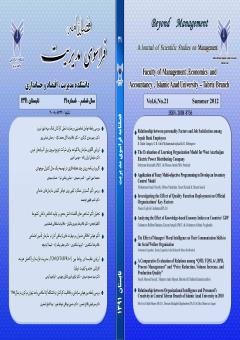کاربرد برنامه ریزی چند هدفه فازی در توسعه یک مدل کنترل موجودی
محورهای موضوعی : مدیریت بازرگانیمحمد امین نایبی 1 , ناصر حمیدی 2 , عباس پناهی نیا 3 , حسام سعیدی 4
1 - دانشگاه آزاد اسلامی، واحد قزوین، باشگاه پژوهشگران جوان، قزوین، ایران
2 - دپارتمان مدیریت صنعتی، دانشکده مدیریت و حسابداری، دانشگاه آزاد اسلامی، واحد قزوین، قزوین، ایران
3 - دپارتمان مدیریت صنعتی، دانشکده مدیریت و حسابداری، دانشگاه آزاد اسلامی، واحد قزوین، قزوین، ایران
4 - دانش آموخته کارشناسی ارشد مدیریت صنعتی، دانشگاه اسلامی کار، قزوین، ایران
کلید واژه: برنامه ریزی چند هدفه, کنترل موجودی, عدد فازی و برنامه ریزی غیرخطی فازی (FNLP),
چکیده مقاله :
در این مقاله یک مدل کنترل موجودی چند کالایی با اهداف کمینه سازی هزینه کل و حداقل بکارگیری نیروی انسانی، تحت محدودیتهای حداکثر فضای انبار، حداکثر توان سرمایه گذاری، میزان کمبود مجاز در هر دوره و مقدار سفارش دوره ای ارائه می شود که دو محدودیت اخیر بصورت بازه ای در نظر گرفته شده است. در مدل ارائه شده کمبود مجاز بوده، زمان تدارک صفر و پارامترهای تقاضا، هزینه(شامل: راه اندازی، نگهداری، کمبود) و منابع محدودیتها بصورت فازی است. اعداد فازی تقاضا و هزینه بصورت مثلثی و اعداد منابع محدودیتها از نوع ذوذنقه ای مثبت می باشند. در حل مدل ابتدا هر یک از توابع هدف مورد نظر به سه تابع هدف تبدیل و محدودیتها از طریق روش نافازی سازی به محدودیتهای قطعی تبدیل میگردند. سپس مدل چند هدفه قطعی حاصل، از طریق روش برنامه ریزی غیر خطی فازی (FNLP) حل شده است. در پایان یک مثال عددی برای تشریح مدل با استفاده از نرم افزار لینگو (Lingo) حل و ارائه می شود.
In this paper, we presented the multi-item inventory control model whose objectives are minimizing total cost and minimizing the number of manpower. This model is formulated under four constraints consisting of storage spaces, budgetary, allowable shortage quantities and periodic order quantities. The last two constraints are considered as interval. In the presented model, shortage is allowable and lead-time is zero. The parameters such as demands, costs (including: setting, maintenance, shortage) and constraint resources are fuzzy. The type of fuzzy numbers in demand & cost is triangular and the numbers of constraint resources are positive trapezoid. In solution methodology, first we converted the cost objective and manpower objective functions to six objective functions and then reduced fuzzy constraints to crisp constraints via defuzzification. Then we solved the resulted crisp multi objective model using Fuzzy Non Linear Programming (FNLP). Finally we presented a numerical example to solve and describe the model applying Lingo software package.
Abo el ata, M.O. and K.A.M kot. (1997), "Multi item EOQ inventory model whit varing holding cost under two restrictions: A geometric programming approach", production planning and control, vol 8, No 4, 608-611.
Chan, W.M., R.N. Ibrahim. (2003), "An EPQ model: Integrating lower pricing, rework and reject situations", production planning of control, Vol 14, No 97, 588-595.
Georg, J., B.Yuan,(2001), "Fuzzy sets and fuzzy logic theory and applications". Prentic Hall of India.
Katagiri, H. and H. Ishii. (2002), "Fuzzy inventory problem for perishable commodities", European journal of operation research, No138, 545-553.
Kumar, S. and A.G. Wami. (2006), "An EOQ model whit fuzzy inflation rate and fuzzy deterioration rate when: a delay in poment is permissible", System science, vol 31, No 5, 323-335.
Matty, K. (2005), "Numerical approach of multi objective optimal control problem in imprecise environment", Springer Science, No 42, 313-330.
Shundi, H. (2006). The Theory of Fuzzy Sets and its Application in Industrial Engineering and Management. Tehran: Publication of Spreading Basic Sciences, (In Persian).
Yadvalle, V.S.S. (2005), "Multi item deterministic fuzzy inventory model", operation research, Vol 22, No 3, 287-295.
Zadeh, A.L. (1965), "Fuzzy sets", information and control, NO 38, 335-338.
Zimmerman, H.J. (1985), "Application of sets theory to mathematical programming", Information science No 16
_||_
Abo el ata, M.O. and K.A.M kot. (1997), "Multi item EOQ inventory model whit varing holding cost under two restrictions: A geometric programming approach", production planning and control, vol 8, No 4, 608-611.
Chan, W.M., R.N. Ibrahim. (2003), "An EPQ model: Integrating lower pricing, rework and reject situations", production planning of control, Vol 14, No 97, 588-595.
Georg, J., B.Yuan,(2001), "Fuzzy sets and fuzzy logic theory and applications". Prentic Hall of India.
Katagiri, H. and H. Ishii. (2002), "Fuzzy inventory problem for perishable commodities", European journal of operation research, No138, 545-553.
Kumar, S. and A.G. Wami. (2006), "An EOQ model whit fuzzy inflation rate and fuzzy deterioration rate when: a delay in poment is permissible", System science, vol 31, No 5, 323-335.
Matty, K. (2005), "Numerical approach of multi objective optimal control problem in imprecise environment", Springer Science, No 42, 313-330.
Shundi, H. (2006). The Theory of Fuzzy Sets and its Application in Industrial Engineering and Management. Tehran: Publication of Spreading Basic Sciences, (In Persian).
Yadvalle, V.S.S. (2005), "Multi item deterministic fuzzy inventory model", operation research, Vol 22, No 3, 287-295.
Zadeh, A.L. (1965), "Fuzzy sets", information and control, NO 38, 335-338.
Zimmerman, H.J. (1985), "Application of sets theory to mathematical programming", Information science No 16

